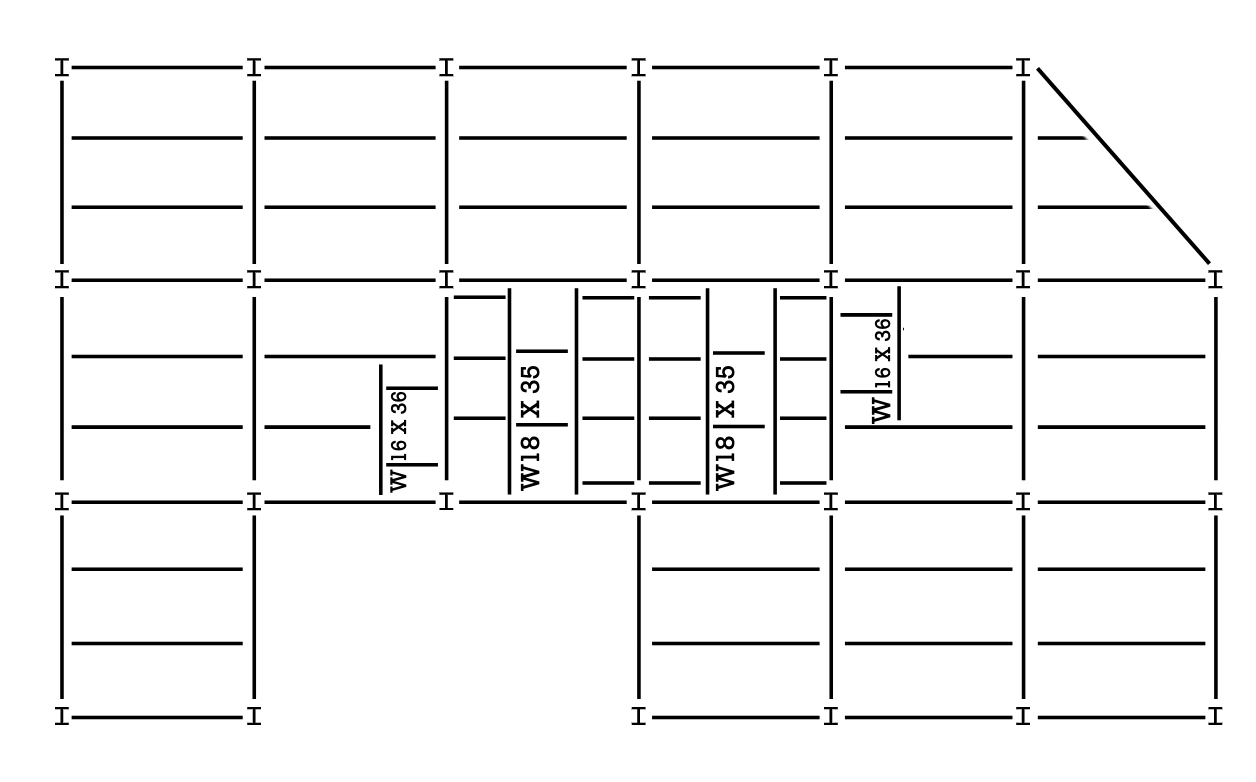ARCH 2615-5615 Building Technology II: Structural Elements
Spring 2022
Jonathan Ochshorn
Assignment 3: Steel-frame construction
Issued March 3, 2022
Due March 8, 2022, 9:40 AM* (upload PDF to canvas)
Solutions
Steel-frame construction: Create a schematic design for a 3–6-story steel-frame building whose plan shape is based on a letter of the alphabet that appears in your name (the alphabet chosen need not be the so-called "Latin" alphabet).
Requirements:
- It is not necessary to design the interior of the building, except where columns are needed to provide structural support. In other words, you can leave out framing required for stairs, elevators, shafts, and so on.
- Assume typical horizontal spans of approximately 30 feet (9.14 meters) for beams and girders, using wide-flange shapes with cross-sections approximately 6-inches wide and 18-inches deep for beams and approximately 8-inches wide and 24-inches deep for girders. Columns can be assumed to be wide-flange shapes approximately 8-inches square. Beams can be assumed to be spaced approximately 8–12 feet apart.
- The building must contain at least one interior column that extends from the ground floor to the roof. This column must remain an interior column on all floors.
- Assume that the second floor framing plan (i.e., the form of the ground floor) represents the shape of your chosen letter, while upper floor plans may be smaller, as long as any cuts correspond to the column lines in either or both directions.
- The total building floor area should be approximately 30,000 – 60,000 square feet (2,800 – 5,600 square meters).
Draw:
- Schematic axonometric or isometric or perspective showing external form of building.
- Typical floor framing plans for each floor and roof level (at any legible scale), including overall dimensions. The framing plans show typical columns, beams, and girders. Do not label, identify, or "design" the beams, girders, or columns. Just label the plans as second-floor framing plan, third-floor framing plan, roof framing plan, and so on. Align the plans vertically, with the roof framing plan on top. [Update 3/4/2022: There is no need to provide a first-floor framing plan.] Here's an example from Edward Allen's textbook, slightly modified (but unlike this framing plan, you need not identify beam names or show special stair/elevator framing):

- Cut-away axonometric or isometric or perspective showing a portion of the framing that extends from footings up to at least the middle of the second floor. It is not necessary to show fireproofing, but show footings, columns, beams, girders, and the composite corrugated steel-concrete floor deck. It is not necessary to include a lateral-force-resisting system, which typically consists of either diagonal bracing or rigid moment frames. In general, lateral-force-resisting systems occur in two pairs (i.e., on parallel surfaces in two orthogonal directions). See the discussion of "Lateral Stability of the Building Frame" in Edward Allen's textbook beginning on p. 419, and also Figure 1.74 in the course text. The curtain wall enclosure and roof surface can be rendered schematically.
Here's an example of a cut-away drawing of a steel-framed building, based on Figure 11.23 from Edward Allen's textbook:

Schematic cut-away steel-framed building, based on Figure 11.23 from Allen, Fundamentals of Building Construction
IMPORTANT: Read chapter 11 from Edward Allen, Fundamentals of Building Construction, available as a free online pdf through the Cornell Library website. See, in particular, Figure 11.23 for a perspective rendering of a typical steel-framed building, and Figure 11.41 for a typical framing plan.
IMPORTANT: Save your drawing files, since they will needed for Assignment 4.
* Note that the grace period for late assignments ends at 9:40 AM on Thursday, March 10, 2022. Assignments will not be accepted after that point.
Copyright
2021–2022 J. Ochshorn. All rights reserved. First posted: 14 March 2021 | last updated: 04 march 2022
ARCH 2615-5615 Building Technology II: Structural Elements
Spring 2022
Jonathan Ochshorn
Assignment 3: Steel-frame construction
Issued March 3, 2022
Due March 8, 2022, 9:40 AM* (upload PDF to canvas)
Solutions
Steel-frame construction: Create a schematic design for a 3–6-story steel-frame building whose plan shape is based on a letter of the alphabet that appears in your name (the alphabet chosen need not be the so-called "Latin" alphabet).
Requirements:
Draw:
Here's an example of a cut-away drawing of a steel-framed building, based on Figure 11.23 from Edward Allen's textbook:
Schematic cut-away steel-framed building, based on Figure 11.23 from Allen, Fundamentals of Building Construction
IMPORTANT: Read chapter 11 from Edward Allen, Fundamentals of Building Construction, available as a free online pdf through the Cornell Library website. See, in particular, Figure 11.23 for a perspective rendering of a typical steel-framed building, and Figure 11.41 for a typical framing plan.
IMPORTANT: Save your drawing files, since they will needed for Assignment 4.
* Note that the grace period for late assignments ends at 9:40 AM on Thursday, March 10, 2022. Assignments will not be accepted after that point.
Copyright
2021–2022 J. Ochshorn. All rights reserved. First posted: 14 March 2021 | last updated: 04 march 2022